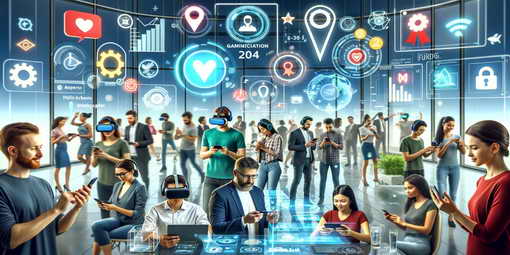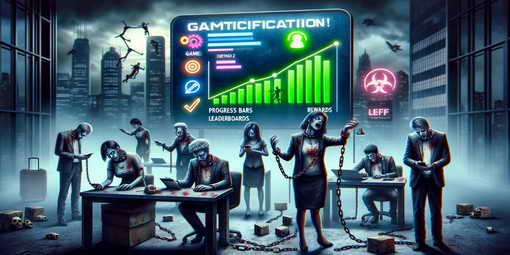Ever since this author watched Orson Scott Card’s Ender’s Game, produced by Gavin Hood, he has been genuinely fascinated by the idea of gamification and how this simple yet ingenious concept can drastically transform our lives, both for better and for worse. Even though the events of this sci-fi movie are set to take place in the distant 2135, gamification has been with us for a couple of decades, stealthily influencing our preferences and behaviors across various domains.
So, what exactly is gamification, and is it really the force for good that we are led to believe? Let us find that out together!
What Is Gamification in 2024?
First introduced online in 2008 in the context of computer software development, gamification involves applying game-like elements (e.g., the ability to earn points and badges, complete levels, undertake quests, etc.) to other fields and areas of focus such as healthcare, education, personal finance, and workplace productivity. The goal is to engage and motivate users to achieve specific objectives.

To make it easier for everyone to understand gamification, here is a simple, down-to-earth example of its everyday application: your city transportation department can collaborate with the local government and use gamification mechanics to introduce improved traffic control measures.
To encourage residents to use public transportation more often and to unload drives during rush hour, these agencies might implement a gamification system where travelers earn points or rewards for each trip they take using community transport. When enough points have been accumulated, they can be redeemed for discounts on future rides, special price offers from local businesses, or entries into various raffles with larger prizes.
What gamification helps achieve within this specific scenario is to promote desirable behavior by setting a clear goal (i.e., use public transport more and gain a tangible reward), to make certain tasks less of a chore (it is a fun game, not something you have to suffer through), and to collect valuable data for future analysis and strategy optimization.
Gamification’s Good Sides: How Does It Benefit Each of Us and The Society in General?
At its core, gamification appeals to our inner child. By leveraging our natural love for games, it aims to make everyday activities more enjoyable and engaging. Here are some key benefits of gamification:
- Increased motivation: incorporating diverse gamification elements makes tasks that might otherwise seem tedious become exciting challenges.
- Enhanced skill-building potential: the game-like elements of gamification can teach the adult workforce essential skills and knowledge.
- Stimulation and reinforcement of positive change: gamification makes positive changes in individual or collective behavior feel rewarding, encouraging repetition.
- Stronger sense of collaboration and belonging to the community: gamification helps create shared goals and competitive environments, uniting people and encouraging teamwork.
- Facilitation of economic growth: by promoting skills development and innovation, gamification drives economic growth and development of the society in general.
Gamification turns mundane tasks into fun and engaging experiences. It boosts user motivation, prioritizing skill development and collaboration. The role of gamification in building a more qualified workforce and driving economic growth is also significant.
Negative Aspects of Gamification: From Misuse by Online “Casino” to Dehumanization
At first glance, gamification is nothing but a positive phenomenon, offering numerous benefits that can significantly impact our personal lives and the well-being of society at large. However, when placed in the wrong hands, it can quickly turn into a rather destructive tool. If used in an irresponsible or unethical way, gamification can lead to a large number of negative outcomes that range from encouraging addictive behaviors to dehumanizing individuals.
Top 3 Ethical Concerns Raised by Gamification Opponents
Below, we explore the darker side of gamification and discuss some of the most condemned ways it is used today.

1. Manipulation by Online Gambling Businesses.
Gamification is a real double-edged sword, particularly when it comes to promoting addictive habits. Online casinos are pros at making gambling feel like a game. Offering a huge variety of thrilling features, these platforms easily suck in users and make them forget about where harmless fun ends and serious addiction begins.
While users might think they are just having a good time playing, the truth is that they are often the ones being played. Online casinos want to keep their visitors hooked, which is why they seek ways to engage our emotions and instincts with well-designed and meticulously crafted experiences.
Misuse case overview: One might argue that online casino games are inherently gambling experiences, and no one expects anything less. While it is true, the issue lies not with the games you pay to play – it is about what comes seemingly free. The so-called add-on gamified experiences are the real problem.
To better visualize this, imagine a “slot game” where you spend money to spin the reels. As you do that, you either lose or win, which is the natural course of events. At the same time, there is a parallel mechanic at play: a progress bar displayed alongside the main gameplay. This progress bar fills up with each spin purchased, promising players a free bonus game once complete. Lured in by the chance to win big, whether it is real money, free spins, or other exciting rewards, players continue funding the main gameplay, only to discover in the end that the reward they win in the bonus round does not exceed the cost of a single spin and is hundreds of times less than what they have already invested.
2. Misuse of Private Information.
To remain functional and effectively serve their purpose, applications where gamification is used need to be able to collect extensive personal information about their users. This data is then analyzed and interpreted to give operators a better understanding of how successful their efforts are and how to tailor the gamification experiences further to meet user needs with even more precision.
This data collection may appear harmless and even beneficial for improving the user experience, yet it raises some ethical concerns regarding situations when such information is misused, specifically for profit-generating purposes.
Misuse case overview: Consider the case with a popular social media platform that utilizes gamification elements to promote user engagement. As users interact with the platform, it tracks and analyzes their behaviors and interactions, offering them a more personalized feed in return. Now, imagine a situation where this social media platform starts mining user data to create detailed profiles of individuals and bombard them with targeted advertising. And it is not just about what users actively search for on the platform – it also contains mentions of things or products they discuss in private conversations with friends. That can easily make one feel violated, to say the very least.
An even worse case of user trust violation would be the platform’s selling user data without consent, which can have severe consequences such as identity theft or phishing scams.
3. User Dehumanization.
Dehumanization involves stripping a person or a group of people of certain positive human qualities. In the case of gamification, it can be the process of making our motivation dependent on external rewards and recognition rather than genuine intrinsic values.
When engaging with gamified systems, whether social media websites, fitness applications, or productivity-boosting tools, our actions are often led by the desire to score badges, points, or virtual rewards. Instead of doing something just because it brings us joy and a sense of fulfillment, we start chasing after some artificial markers of success and often resort to cheating in the process.
Examples are many: we may give a certain social media post a thumbs-up not because we appreciate its content but because the post creator promised a giveaway of rewards. Similarly, we might do physical exercise just because we want to unlock an achievement within our fitness-tracking app. With gamification, many of our interactions with each other and the world lose authenticity and become purely transactional.
Misuse case overview: Let us look at how gamification can be misused in the realm of education, leading to the dehumanization of users. Here is a common scenario: a language-learning app uses elements of gamification like badges or a scoring system to encourage learners to work on improving and expanding their vocabulary. Normally, it would be a creative and engaging way to motivate and promote language adoption. However, in some apps, the game aspect prevails over the need for genuine learning outcomes, which results in users being more preoccupied with earning rewards than they are with actually developing skills.
When the destructive powers of gamification are on, the unique and enjoyable experience of learning a new language is sometimes reduced to a mechanical process of memorizing words long enough to score a few points before moving on to the next step/level/reward. It can be worse: some users do not bother with learning anything and instead use various cheats to give the impression of progress.
These are just a few examples of how gamification can take a dangerously wrong turn when misused. To avoid these pitfalls, one could consider the following tips:
- keep communication with users regarding gamification clear and transparent
- prioritize the ethical design of applications that rely on gamified elements to engage users
- give users the option to turn off gamification entirely if they so desire
- make sure gamification is not exclusive or discriminating
- build gamification efforts around fostering authentic human connections.
Whether adopted on a personal or institutional level, these tips can help create a healthier, fairer, and more ethical gamification experience that all would enjoy.
Closing Thoughts on Gamification
To wrap it up, gamification is a complex concept with multiple facets and dimensions. While its ability to engage and motivate is undeniable, gamification does come with its fair share of downsides, and they are not something to dismiss lightly. However, it is also crucial to recognize that gamification is just an instrument without its own agenda. Whether it benefits people or causes harm ultimately depends on how we use it.





